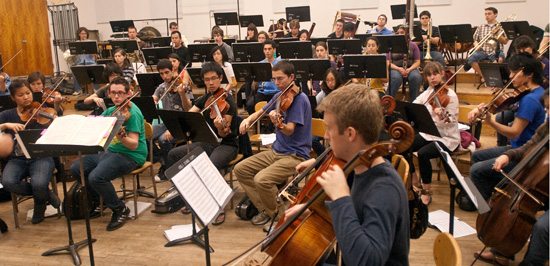Students take the lead in tonight’s Philharmonia concert

The UCLA Philharmonia, conducted by Professor Neal Stulberg, rehearses Tuesday for its upcoming performance of Rachmaninoff’s “Symphonic Dances” tonight at 8 p.m. at Schoenberg Hall. Stulberg will be absent during the first half of the performance.
By Christopher Robinson
April 14, 2010 8:44 p.m.
Performing famous classical music pieces is par for the course for the UCLA Philharmonia’s student-musicians, but performing them without a conductor is charting a bit of unfamiliar territory.
Tonight’s performance in Schoenberg Hall will feature performances of Mendelssohn’s “Violin Concerto in D minor,” Dvorak’s “Serenade for Woodwinds, Cello and Bass in D minor” and the fully orchestral Rachmaninoff piece from which the concert takes its name, “Symphonic Dances.”
“To do anything unconducted with a large group is a huge challenge,” said Professor Neal Stulberg, who is also a conductor. “The group has to come together and figure out a way to turn a multi-instrumental piece into a unified and living piece of music, without having the conductor there to lead everybody along the way.”
Stulberg will be conducting the last half of the concert, which features the fully orchestrated Rachmaninoff symphony, but is stepping down from his role as conductor and letting the student-musicians work together to bring the Mendelssohn and Dvorak pieces to life. The talented student-musicians are not without guidance and hope in accomplishing such a task.
“You have to treat these pieces like chamber music,” said Henry Shin, a second-year graduate student in orchestral conducting. “Everybody’s parts are very intricate, and at the same time you are learning your own part, you must be learning everybody else’s parts as well. In a way, they are all taking on the role of conductor.”
The students have done what many musicians in their place would do, developing a system of signals with each other to use throughout their performance, and an audience is sure to catch on to the musicians being far more actively aware of each other’s parts.
Keeping the groups together will be a challenge, but both groups of students performing the two pieces will have a pair of musicians who have been designated as leaders, and they have the large responsibility of keeping the performances tight and on track.
For Mendelssohn’s “Violin Concerto in D minor,” the de facto leader is violin soloist Ji Young An, a second-year master’s student in violin performance.
“It’s a lot of pressure, but it’s really exciting to be leading a group in creating such an emotional and passionate piece,” An said. “It’s also exciting to be playing Mendelssohn’s less well-known concerto for violins.”
Many audience members are likely to be more familiar with Mendelssohn’s “Violin Concerto in E minor,” but An said she believes that playing the D minor concerto will bring a fresh perspective to Mendelssohn’s compositional excellence.
For Dvorak’s “Serenade for Woodwinds, Cello and Bass in D minor,” the group will look to Theodosia Roussos, a fourth-year music student specializing in oboe performance, for musical guidance.
“My part has a lot of the primary melodies, and I have to start all of the movements and be responsible for setting the tempo and making sure everybody is on board,” Roussos said. “I’ve never had to lead a rehearsal. It’s given me a real taste for what the conductor has to go through.”
The learning experience has been beneficial for everybody in this situation, and the students have become more aware of how they fit into the entire ensemble and performance.
“Playing the Dvorak has been a great experience with such an intimate group,” Roussos said. “We don’t have somebody showing us the emotion, so our energy is feeding off of each other’s energy and each other’s emotions.”
After an entire first half without a conductor, the strings and winds will come together in the second half to play Rachmaninoff’s famous “Symphonic Dances,” led by Stulberg and equipped with new tools for tackling their performances with energy and enthusiasm.
“It’s both a flashy and meltingly beautiful piece at the same time,” Stulberg said. “Since Rachmaninoff emigrated from Russia to live in Beverly Hills and compose this piece, I like to think of it as Russian Romantic music meets Hollywood.”
The selection sounds just like that, with the depth of feeling of a Romantic-era composition and the big orchestral colors and intricate rhythms of a classic Hollywood score. It will certainly serve as a grandiose conclusion to this rewarding evening.
According to Stulberg, his role (or lack thereof) in the concert is an important teaching tool for the musicians involved.
“A conductor has to sometimes intervene as a focus of energy,” Stulberg said. “But sometimes the best thing a conductor can do is to disappear so that the group develops a way of listening to each other.”

